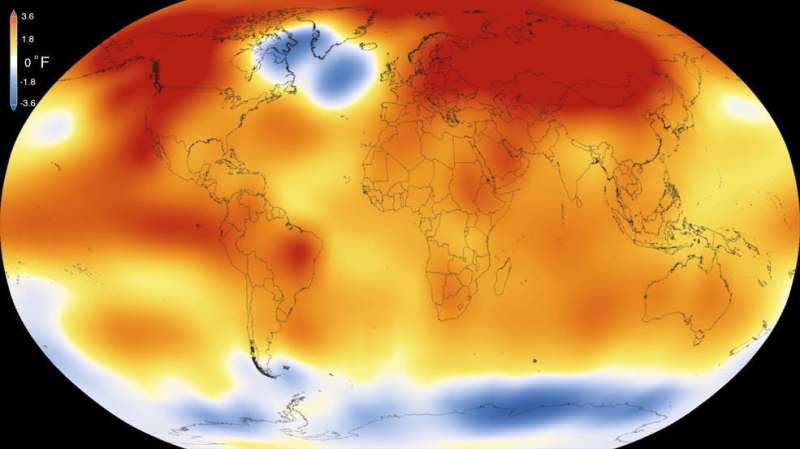The year 2015 was the warmest since modern record-keeping began in 1880, according to analysis by NASA’s Goddard Institute for Space Studies. Credit: NASA
Approximately 117 million more people could face water shortages if global temperatures increase 2 degrees Celsius above pre-industrial levels compared to a 1.5-degree Celsius increase in temperatures, a new study suggests.
The world's water cycle, including evaporation and precipitation, is expected to intensify with global warming, according to the study. This could affect the distribution of freshwater and constrain the global water supply, which poses risks to national food security, economic prosperity and societal well-being.
In a new study, published in Geophysical Research Letters, a journal of the American Geophysical Union, researchers examined how global freshwater could change under 1.5- and 2-degree Celsius increases in temperatures, targets set forth in the Paris Agreement.
Researchers used a newly-released model to determine a global assessment of water availability below normal conditions. The new model, called HAPPI experiments, is specifically designed to differentiate impacts between 1.5- and 2-degree Celsius warming targets.
"This is the first study to explore how limiting warming to 1.5 degrees [Celsius] would benefit global population exposure to water shortage using the HAPPI experiments," said Wenbin Liu, lead author of the study and assistant professor at the Chinese Academy of Sciences. "Some regions would be better off, but some regions would be worse off."
Previous research found more people worldwide would suffer from water shortages when temperatures increase. The new study shows the benefit of maintaining global warming at 1.5 degrees Celsius. Limiting global warming at 1.5 degrees Celsius translates to a less-severe decrease in water availability below normal conditions across most regions, including east and south Asia, east and west Africa and central Europe. For a few regions, however, this limit would be ineffective. Southeast Asia, northern Asia, southern Africa, southern Europe, the Mediterranean, eastern Canada, Greenland, Iceland, Alaska and northwest Canada would experience worsening water availability below normal conditions under both 1.5 degrees Celsius and 2 degrees Celsius of warming.
"Notably, limiting global warming at 1.5 degrees Celsius instead of 2 degrees Celsius would constrain the number of people suffering water shortage induced by water availability below normal conditions in many regions," second author Wee Ho Lim, of the Chinese Academy of Sciences and University of Oxford, said. "Nonetheless, such a limit is less effective in Alaska and northwest Canada, southeast Asia and the Amazon."
The findings of the new study provide international policymakers with information about the societal impact of water shortages triggered by freshwater availability below normal conditions on global and regional scales, according to the study.
"Apparently, there's going to be a spatial variation across different parts of the world," Lim said. "When you look at the global average, you can see the increasing drought risk should we not try our best to limit our greenhouse gas emissions to maintain the warming at as low a temperature as possible."
More information: Wenbin Liu et al. Global Freshwater Availability Below Normal Conditions and Population Impact Under 1.5 and 2 °C Stabilization Scenarios, Geophysical Research Letters (2018). DOI: 10.1029/2018GL078789
Journal information: Geophysical Research Letters
Provided by American Geophysical Union
This story is republished courtesy of AGU Blogs (http://blogs.agu.org), a community of Earth and space science blogs, hosted by the American Geophysical Union. Read the original story here.























